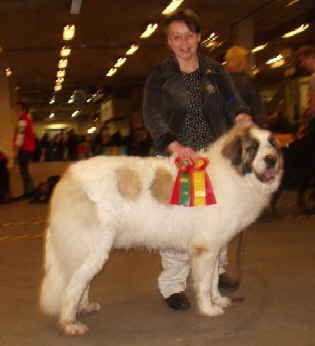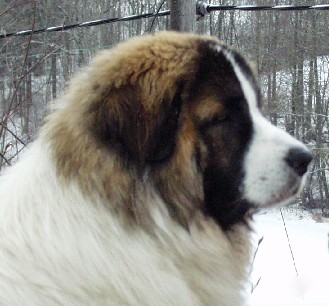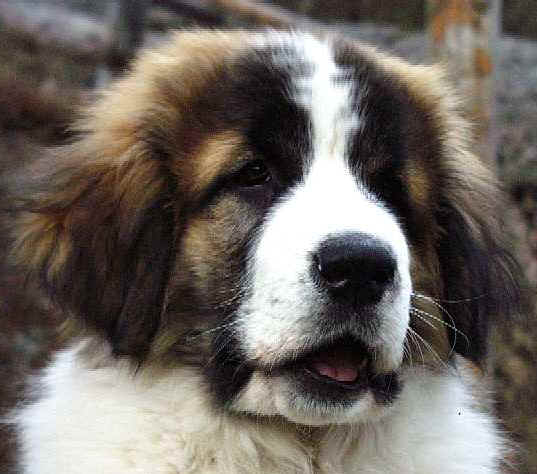Kennel Av Molaslia (Owner: Edith Lien) SVNVCH Ojinegra's Que Boinita Chica. |
Kennel Av Molaslia (Owner: Edith Lien) SVNVCH Ojinegra's Que Boinita Chica. |
This Mastin Del Pireneo Breed History Written By Mr Finn Espen Nergard.
HISTORY.
The Pyrenean mastiff, also called Mostin De Aragon or Mastin Del Pirineo, are one specific
breed among many other big dogs called Molossier dogs. The function of the Pyrenean
Mastiff was to follow herds of sheep from winter to summer grazing land to guard and
protect them along the way, against wolves, bears & thieves.
The Pyreneans distant relatives were probably the big dogs brought from Mesopotamia
& Asyria to Spain about 400 years b.c. You can find remnants form big dogs in
excavations south in Spain but we haven't exactly heard of these dogs before 1273. At that
point there is the first documentation of mastines. ( Liber indicium - law5, paragraph 4 ,
book 8 )
"Banda" Bred by The Kennels Of Av Moloslia. Kind permission of owner Finn Espen Nergard. |
In the year 1450 the so called , Sheep
& Herd Federation, was formed in Spain. At that time the federation was very powerful
largely due to the sheep driven economy. In the kingdom of Aragon alone you
could find about 1.750.000 sheep in the 15th century. The quantity of wool exported was
enormous, about 2.000.000kg wool per year. One statement by this federation said that:
1. Everyone who hurts or damaged a mastin recieves a penalty of 5 sheep.
2. Mastins are to be treated with special care and to be given the same food as the
shepherds.
3. Apon finding a "lost" mastin you are to give it to the federation, Who in
turn will find a suitable solution / new owner.
4. Every flock of sheep (1000 pieces) shall have 5 mastins to guard them.
 SVCH Bombacho-Basilio De Cabana De Otaula.Breeder Mr Deigo Galan. Owner Edith Lien. |
From what we understand of these laws,
the mastins were highly prized and of great value !! The Pyrenean Mastiff have some joint
concerns with other mastines like the Spanish Mastiff, Mastiff de leon and so on.. but for
several hundred years it was isolated because of the situation/location. This in addition
to the climate and the "old breed" has lead to our Pyrenean mastinos.
The nearest relative is probably the Pyrenean mountain dog. These two breeds were probably
common until the pyrenes were split almost in two different parts . North became France
and south became Spain . Another relative is also found in Spain, the Spanish Mastiff.
This breed is from the lower located parts of Spain and because of the climate and
location it is now a different breed in many ways.(e.g. shorter coat).
The Grandsire Of Diano.ESCH Ezkabarte De Larresalkoak |
BREED DESCRIPTION
The Pyrenean mastiff are a rectangular big and strong dog. The minimum height for females
are 72cm or 28" and for males 77 cm,or 30 " The biggest individual is always
preferred. There are no upper limits regarding the height. The head is big and wide with a
slight but definite stop. The ears are medium sized are placed highly above the eyeline.
Colour of the eyes are brown with a calm and intelligent look.
The nose is powerful which gives the face a deep profile. The throat is strong and heavily
coated which helps the dog to protect itself during possible attacks. The shoulders are
massive, bent, with powerful muscle substance. The backline is straight, but a slightly
swaying backline allowed. this trait was found often among the old mastines.
 Mr Finn Espen Nergards: Nitro at one year of age. |
The bone structure is powerful and massive. The front legs should be separated to make
room for a wide and deep breast. The back legs have to be strong and angled well enough to
give a powerful impulse to the dog. Double dewclaws are usual but not obligatory.
The PM has a tight, coarse and moderate long coat between 6-9 cm. This is longer on the
shoulders, throat, under the stomach and on the backside of the legs. The base colour is
always white with a characteristic mask covering both ears. Usually there are several
spots on the rest of the body, but they have to be well defined and with the same colour
as the mask. Colours are grey, golden, brown, silvergrey, black, marmorated, and
sandcolored but never red !!
AAn example of the Pyrenean Mastiff gentle nature. Illio and his son Diano. |
BEHAVIOUR
The temperament is not complicated, the PM will learn fast and his behaviour is very
routine. Even if the Pyrenean mastiff appears passive, it will always be aware of
everything that goes around it. This kind of behaviour makes the dog very stable even in
extreme situations. This of course in addition to that the fact that this dog is aware of
its power, strength and size. The Pyrenean mastiff is not an aggressive dog, it will
seldom look for trouble. But with a smoothness and quickness in the movement , he is well
prepared to take it. The male , as a lover, will not accept any competition from other
dogs. He has almost no time to eat and just in this situations he will leave the female.
The female is almost the opposite, very feminine and would like to be flirted with by 2 or
even more males. When visiting places where an PM is located, you will always be meet by
deep barking. The Pyrenean mastiff assure you that you are walking on private property and
after an complete inspection the he will follow you to the door….. or keep on barking
if he doesn't like what he has inspected. The behaviour is very dependable. Saying
this he is willing to give his friendship away, especially to children !!
 Mr Finn Espen Nergards "Nitro" |
The Pyrenean mastiff will adore the children of the household.. If you, as an adult, are
angry with the children, he will always protect them and take their side. The owners
and family are the ones he loves the most and will have most confidence in. The Pyrenean
mastiff likes short and simple commands, used from day one !! With an hard and
punished education you will get a shy ,nervous and uncomfortable dog. The Pyrenean mastiff
tolerates well a pretty hard climate over long periods due to the long and strong coat. It
will search for the highest part on the property and lay down there for hours just doing
almost nothing but be aware…
Serrano From The kennel Av Moloslia. Kind Permission of Finn Espen Nergard. |
EVOLUTION
The Pyrenean mastiff became an "offer of the time " in the 1930 `s. Things
happened which lead to less work for the dogs and it became less important. Wolves and
other predators were almost wiped out and the railway started to transport the sheep more
and more… In addition of course, there was civil war between 1936-39 and the world
war 2 which meant there was less food available to spare on giant breed dogs. All this
lead to an dramatic reduction in numbers of Pyrenean mastiffs.
Luckily there were dedicated
enthusiasts who had either had these dogs or heard about them. They travelled around Spain
and found about 100 dogs. Of these only 30 were used to start the breeding program
again ! The Spanish club had only one mission in mind, to save the Pyrenean mastiffs
existence and to make the breed known in rest of the world. Even though he may be a
relatively seldom seen dog , you could say that the "pioneers" have succeeded in
their mission. The Pyrenean Mastiff is found in many countries across Europe US.
Today you will find about 4000 Pyrenean mastiffs in Spain.
Kind Thanks To Finn Espen Nergård for allowing the use of this text.